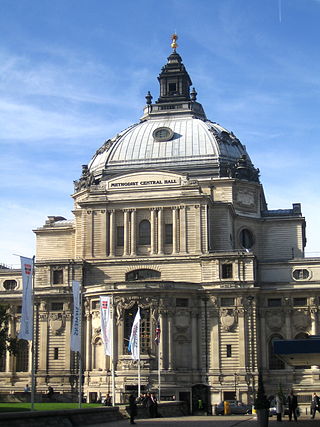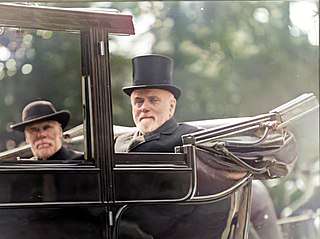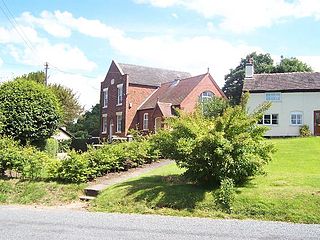Related Research Articles
James Harrison Rigg was an English nonconformist minister and Methodist educator.

Longnor is a village in the Staffordshire Peak District, England. The settlement dates from early times, the first recorded church building being in the Middle Ages. The village was named Longenalre in the Domesday Book. Located on a major crossroads, Longnor was a significant market town in the 18th century. It lies on the north bank of the River Manifold, on a limestone ridge between the Manifold and the River Dove.

Hetton-le-Hole is a town and civil parish in the City of Sunderland, Tyne and Wear, England. It is in the historic county of Durham. A182 runs through the town, between Houghton-le-Spring and Easington Lane, off the A690 and close to the A1(M).
The Primitive Methodist Church is a Methodist Christian denomination within the holiness movement. It began in England in the early 19th century, with the influence of American evangelist Lorenzo Dow (1777–1834).

Primitive Methodism was a major movement in English and Welsh Methodism from about 1810 until the Methodist Union in 1932. It emerged from a revival at Mow Cop in Staffordshire. Primitive meant "simple" or "relating to an original stage"; the Primitive Methodists saw themselves as practising a purer form of Christianity, closer to the earliest Methodists. Although the denomination did not bear the name "Wesleyan", Primitive Methodism was Wesleyan in theology, in contrast to the Calvinistic Methodists.

Hugh Bourne along with William Clowes was the joint founder of Primitive Methodism, the largest offshoot of Wesleyan Methodism and, in the mid-19th century, an influential Protestant Christian movement in its own right.
William Clowes (1780–1851) was one of the founders of Primitive Methodism.

Weston is a village and former civil parish, now in the parish of Weston and Crewe Green, in the unitary authority area of Cheshire East and the ceremonial county of Cheshire, England. The village lies 3 miles to the south east of Crewe. The parish also includes the small settlements of Carters Green, Gorstyhill, Rose Hill, Snape, Stowford and part of Englesea Brook, as well as the new settlements of Wychwood Park and Wychwood Village. Plans in 2015 to develop a golf course surrounding Wychwood Village for residential housing have been opposed by some residents. The plans were refused planning permission by Cheshire East Council; the developer was later unsuccessful in an appeal to the Secretary of State and the council's refusal was upheld. Nearby villages include Basford, Hough and Shavington. In 2011 the parish had a population of 1,855.
The tiny hamlet of Ramsor in North Staffordshire played a significant part in the origins of Primitive Methodism. Listed in the Domesday Book as Ramshorn, this ancient hamlet is a typical example of the depopulation of the countryside. Very little now remains of this village apart from a few farms and cottages. The Primitive Methodist Chapel is the only surviving public building.

Methodist Union was the joining together of several of the larger British Methodist denominations. These were the Wesleyan Methodists, the Primitive Methodists, and the United Methodists. The process involved many years of negotiation and discussion, as well as a vote by the members of each denomination to approve the union. In 1932 a Uniting Conference met on 20 September in the Royal Albert Hall, London. It adopted the Deed of Union as setting forth the basis of union and declaring and defining the constitution and doctrinal standards of the Methodist Church, and a new Model Deed was executed.

Holliday Bickerstaff(e) Kendall, was a Primitive Methodist Minister, President of the Conference (1901). Editor, author and historian, Kendall wrote three separate histories of the Primitive Methodist Church which came to be regarded as the definitive history of the Church.

The organisation of the Methodist Church of Great Britain is based on the principle of connexionalism. This means that British Methodism, from its inception under John Wesley (1703–1791), has always laid strong emphasis on mutual support, in terms of ministry, mission and finance, of one local congregation for another. No singular church community has ever been seen in isolation either from its immediately neighbouring church communities or from the centralised national organisation. Wesley himself journeyed around the country, preaching and establishing local worshipping communities, called "societies", often under lay leadership. Soon these local communities of worshipping Christians formalised their relationships with neighbouring Methodist communities to create "circuits", and the circuits and societies contained within them, were from the very beginning 'connected' to the centre and Methodism's governing body, the annual Conference. Today, societies are better known as local churches, although the concept of a community of worshipping Christians tied to a particular location, and subdivided into smaller cell groups called "classes", remains essentially based on Wesley's societies.

Rev. Richard Jukes (1804–1867) was a popular Primitive Methodist minister and hymn writer. This article provides a brief biography, and a summary of his work as a popular minister and hymn writer during the first half-century of Primitive Methodism.

Sir William Pickles Hartley was an English jam manufacturer and philanthropist who founded the Hartley's jam company.
The Wesleyan Methodist Church was the majority Methodist movement in England following its split from the Church of England after the death of John Wesley and the appearance of parallel Methodist movements.

Rev. George Cosens (1805–1881) is the "first reported West Indian minister to hold a pastorate in Britain." He originated from Jamaica, and lived most of his life in Britain having moved to London to study and joining the Primitive Methodists in his late teens. After working as a Primitive Methodist preacher, he joined the Baptists and from 1837 served as a minister in various Baptist churches. He died in working retirement in 1881. George Cosens married twice, Mary Burnet, 1830, and being widowed, Betsy Dancer in 1841. He is buried in the cemetery of Brierley Hill Baptist Church.
Weston is a former civil parish in Cheshire East, England. It contained 17 buildings that are recorded in the National Heritage List for England as designated listed buildings. Of these, one is listed at Grade II*, the middle of the three grades, and the others are at Grade II. The parish contained the villages of Weston and Englesea-Brook, and the southern part of the Crewe Hall estate. The listed buildings include houses, cottages and a lodge in the Crewe estate.. Elsewhere there are houses and cottages, a public house, a church, and a signpost. In Englesea-Brook the former Primitive Methodist church is now a museum, and its founder has a memorial in the churchyard opposite.

Englesea Brook Chapel and Museum is in the village of Englesea-Brook, Cheshire, England. Built in 1828, the chapel was one of the earliest chapels of the Primitive Methodist movement, and the Sunday school was added in 1914. Since 1986 it has been a museum of Primitive Methodism. The building is recorded in the National Heritage List for England as a designated Grade II listed building. In the chapel is a historic pipe organ. The museum contains artefacts relating to the movement, and arranges a changing programme of exhibitions and other events. In the graveyard near the museum is a monument to Hugh Bourne, founder of the movement.
James Crawfoot(also spelled Crowfoot, Crofoot, Crawford) was the leader of the 'Magic Methodists' or 'Forest Methodists' who influenced Hugh Bourne and William Clowes, the founders of Primitive Methodism.
References
- 1 2 "The Primitive Methodist magazine". Oxford Library. Retrieved 24 March 2016.
- ↑ H B Kendall, History of the Primitive Methodist Church, 1919, page 82.
- ↑ H B Kendall, op. cit., 1919, page 82.
- ↑ H B Kendall, op. cit., 1919, p. 176, Table III, "showing the Succession of Book Stewards and Editors from 1843 to the Present Time".